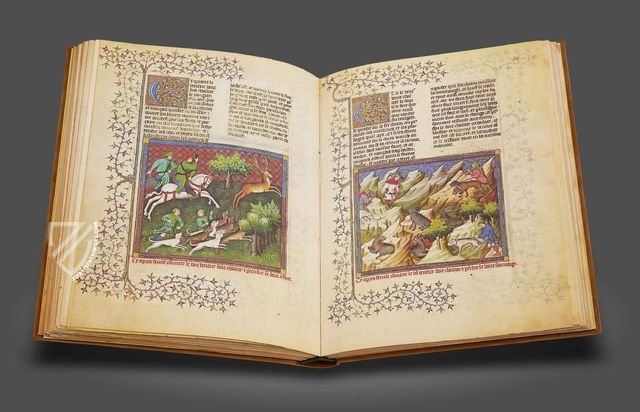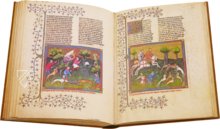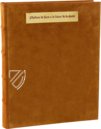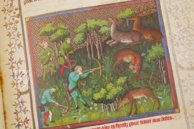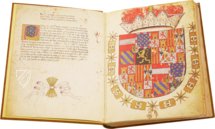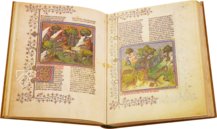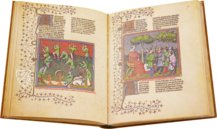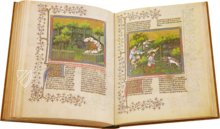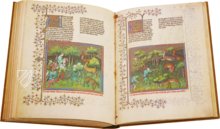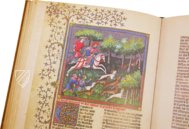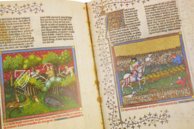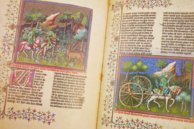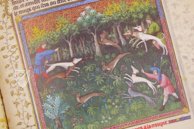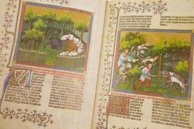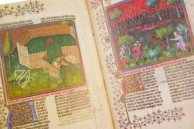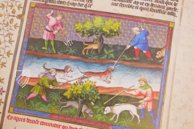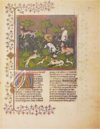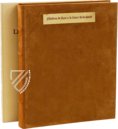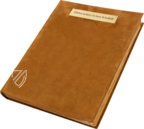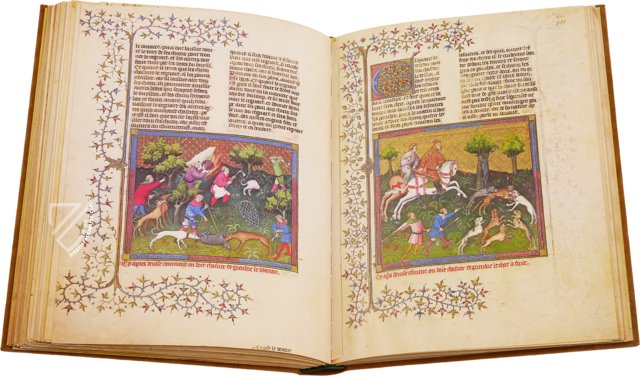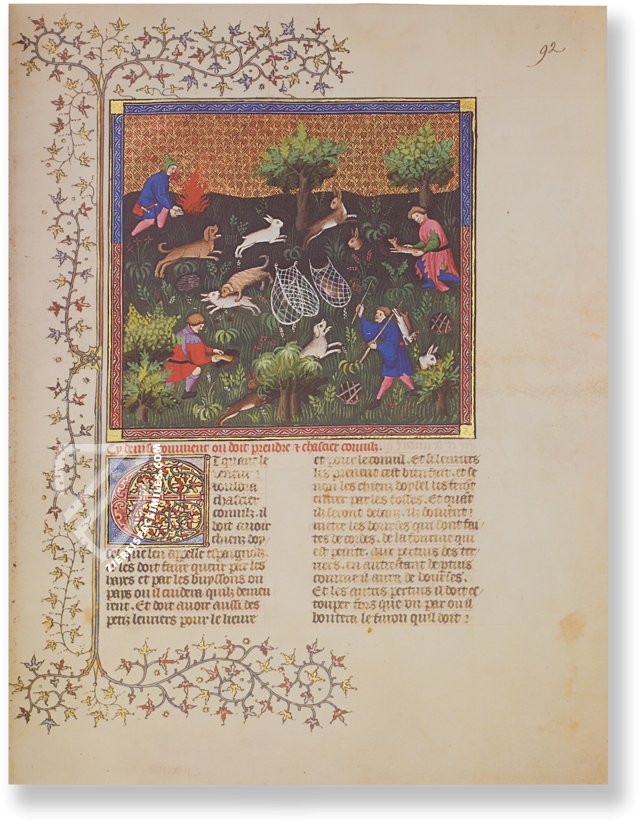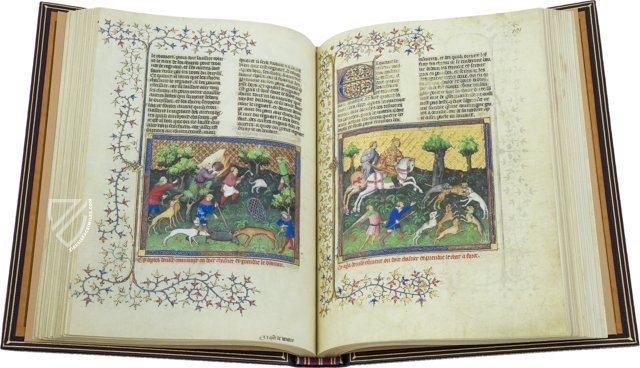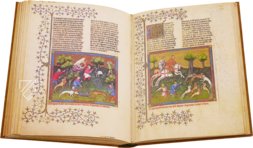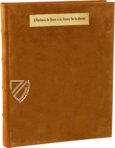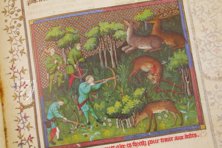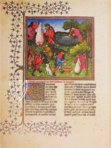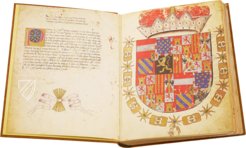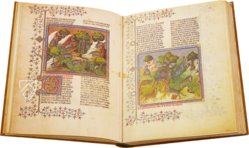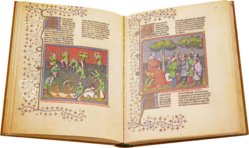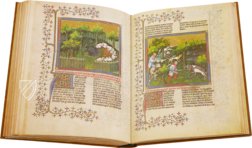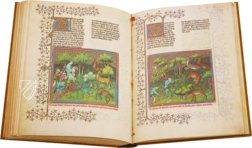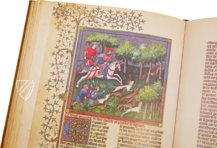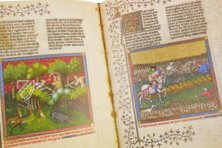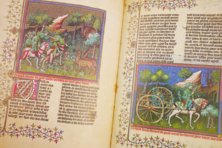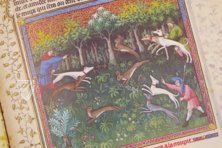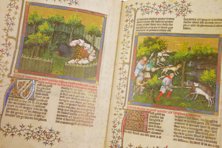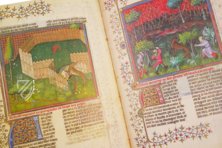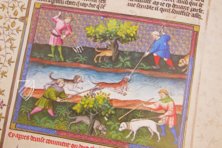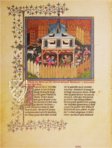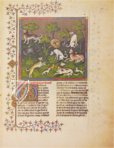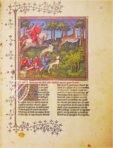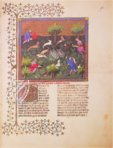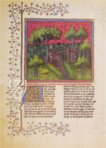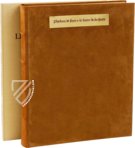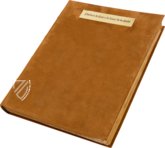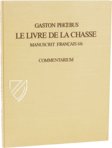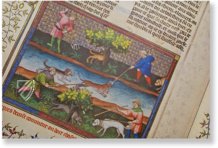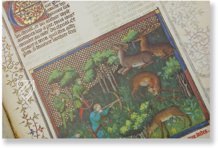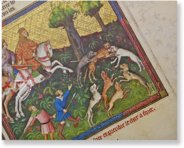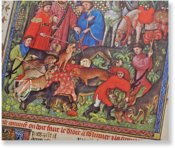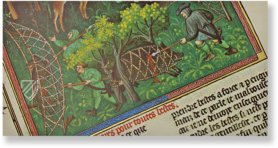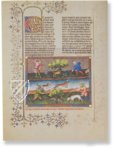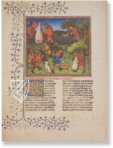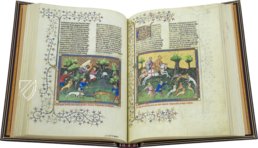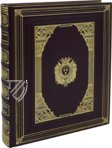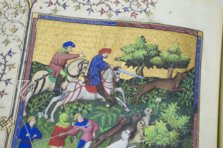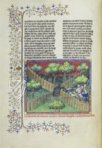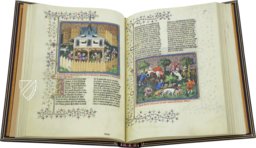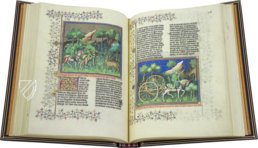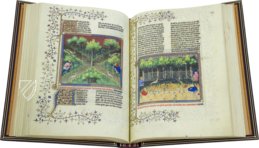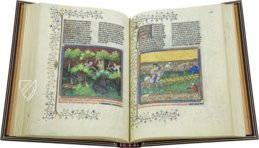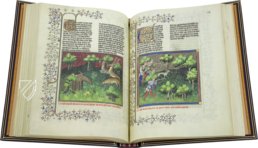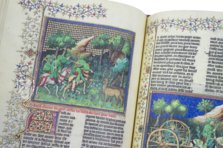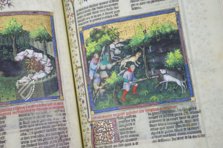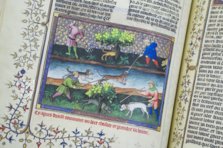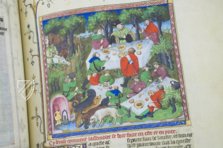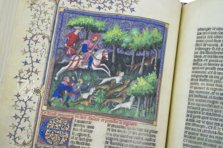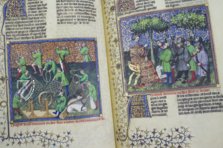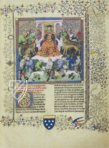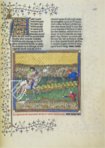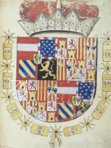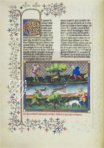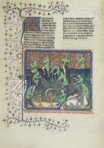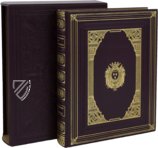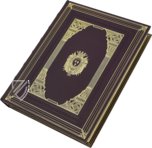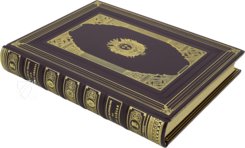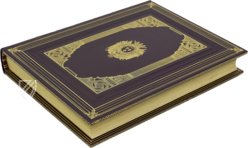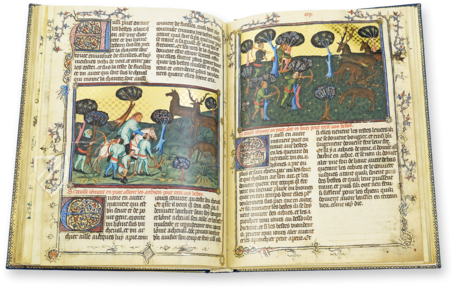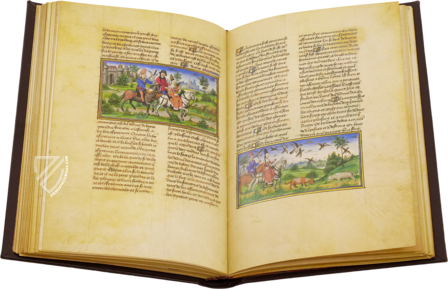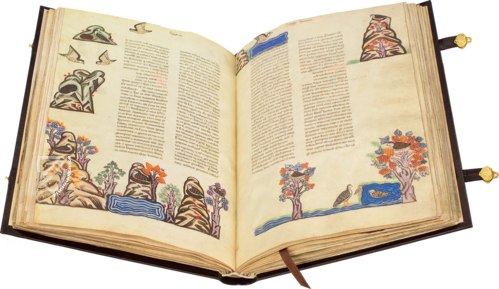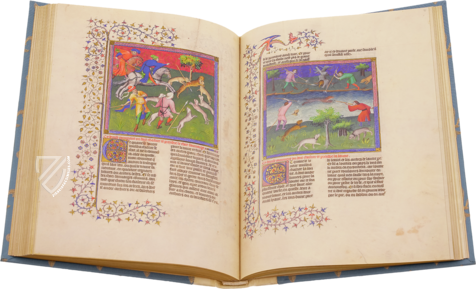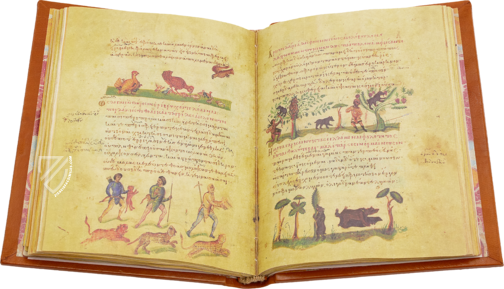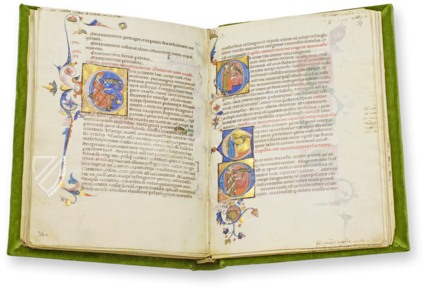Gaston Phoebus - Le livre de la chasse
(under 1,000€)
The Livre de la Chasse or Book of the Hunt by Gaston Phoebus is the authoritative source on hunting in the Late Middle Ages and is one of the greatest gems of French illumination to survive today. It features 87 miniatures embellished with the generous application of gold leaf, but what makes the text unique is its author: the Count of Foix, Gaston "Phoebus" III. This manuscript belongs among a select few that were authored by members of the medieval nobility, such as the Art of Falconry by Frederick II. Originally composed in the 1380's, the text was transformed into a luxury manuscript in a Parisian workshop during the early 15th century. The manuscript comprehensively deals with the subject of hunting, and Gaston III even devotes considerable space to the hunter's greatest resource: dogs, and as such comments not only on breeding and training dogs but on their character as well.
Gaston Phoebus: Le livre de la chasse
The Livre de la Chasse by Gaston Phoebus, which was later to be translated into English under the title of Book of the Hunt, is one of the most precious gems ever produced in medieval French workshops with illumination of outstanding quality. Its 87 miniatures are mostly painted on "stencil pattern" backgrounds and are unique in book painting, most of them richly embellished with gold. They present animals and lively hunting scenes with an unequalled sense of nature. The manuscript enjoyed great popularity for its text as well, which is written in excellent French and is of great significance for the history of hunting. The author, Gaston III Count of Foix, surnamed Phoebus, probably because of his bright blond hair, wrote this sophisticated piece of literature in the 1380's. He was an excellent, experienced master of the art and practice of hunting. It is to him that we owe our general knowledge on the art of hunting as it was practiced in the 14th century.
The Sumptuous Miniatures
The miniatures pay homage to the hunting tradition on a very high artistic level. They are the work of a team of artists who were active in a Parisian workshop of the early 15th century. The artfully designed and lavishly decorated backgrounds of the miniatures remind us of tapestries in a small format. This background painting required much patience and extreme precision and was the work of specialized craftsmen. The illumination of the book was performed in two stages: first, the figures, animals, surrounding landscape and different objects, were painted. In this phase, the artists impress us not least with realistic, detailed illustrations and the vivacity of figures. Then the rich floral ornaments were added. The delicate thorny leaf ornaments have a very special charm. Winding around the miniatures and numerous initials in red and blue on gilded ground, they are dispersed throughout the manuscript for the enjoyment of the reader.
All about Hunting
In his Book of the Hunt, Gaston Phoebus describes the animals of the chase, their character and behavior. Besides surprising and curious details, the reader will find extended passages of familiar facts and even modern tricks of the trade allowing him to reflect his own experience and see whether the evidence allows for bridging the gap of 600 years of intellectual history. Gaston also dedicates much of his book to the dog, the most faithful companion of the hunter. He indulges in reflections on the dog’s character, but also on diverse breeds and their appearance. One also finds rules of behavior for the correct training and care of these animals which are essential to the hunt. The passionate hunter also deals with coursing, the pursuit of game by hounds hunting by sight, in detail.
A Very Popular Work
At a time when hunting played a major role in noble circles, the great echo made by the Book of the Hunt by Gaston Phoebus was only natural. It immediately became very popular and very soon its fame extended far beyond the borders of France, especially to England. The text became a true best seller and was often copied, translated, illustrated and – with the invention of the printed book – published in numerous editions.
Codicology
- Alternative Titles
- Gaston Phoebus - The Book of Hunt
Buch der Jagd von Gaston Phoebus
Jagdbuch des Mittelalters
Libro de la Caza - Size / Format
- 275 pages / 37.0 × 28.0 cm
- Origin
- France
- Date
- Ca. 1405–1410
- Epochs
- Style
- Language
- Illustrations
- 87 hunting scenes in vivid miniatures, mostly painted on ”stencil pattern” backgrounds; rich floral ornaments
- Artist / School
- Gaston III Count of Foix (1331–91) (author)
- Previous Owners
- Poitier family
Bernardo III Clesio (1484–1539), Bishop of Trento
Archduke Ferdinand I of Tyrol (1503–64), Holy Roman Emperor
King Louis XIV of France (1638–1715)
Louis Alexandre de Bourbon (1678–1737), Count of Toulouse
Louis Jean Marie de Bourbon (1725–93), Duke of Penthièvre
Orléans family
King Louis Philippe I of France (1773–1850)
Gaston Phoebus - Le livre de la chasse
A Successful Boar Hunt
Wild boar are some of the most dangerous of all game animals, not only willing to attack humans, but known to still be perilous even when fatally wounded. Even with the assistance of fierce dogs, facing off with a boar, spear in hand, was about as close to combat as a knight could get in times of peace. This scene presents the aftermath of a successful boar hunt: one man is field dressing the beast while others build a fire, tend to the dogs, and cut vegetables.
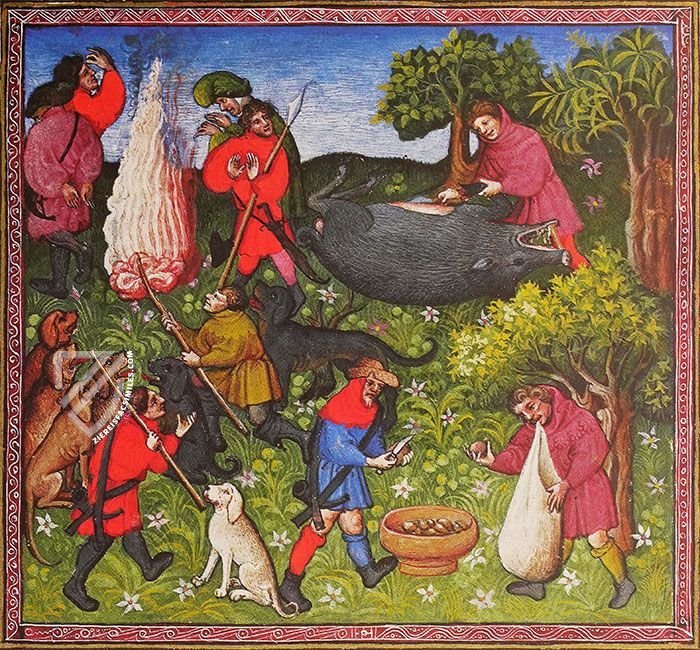
Gaston Phoebus - Le livre de la chasse
On Hunting Rabbits
This page is remarkable both for its artistry and for its density of information. The scene unfolds before an intricately-patterned background of red and gold and is contained within a colorful, patterned, and gilded frame. A full range of greens ranging from dark to light give a sense of depth in the scene, contrasted by the red-orange of the fire being set.
Amidst the trees and bushes, numerous hunters and dogs are pursuing the rabbits. Two nervously stick their heads out of their holes, while other holes have been blocked with sticks to deny the rabbits’ escape to their underground refuges. Four rabbits have been caught, one in a snare, another by a hunting dog, and the other two are slung over the shoulder of a hunter in a blue tunic.
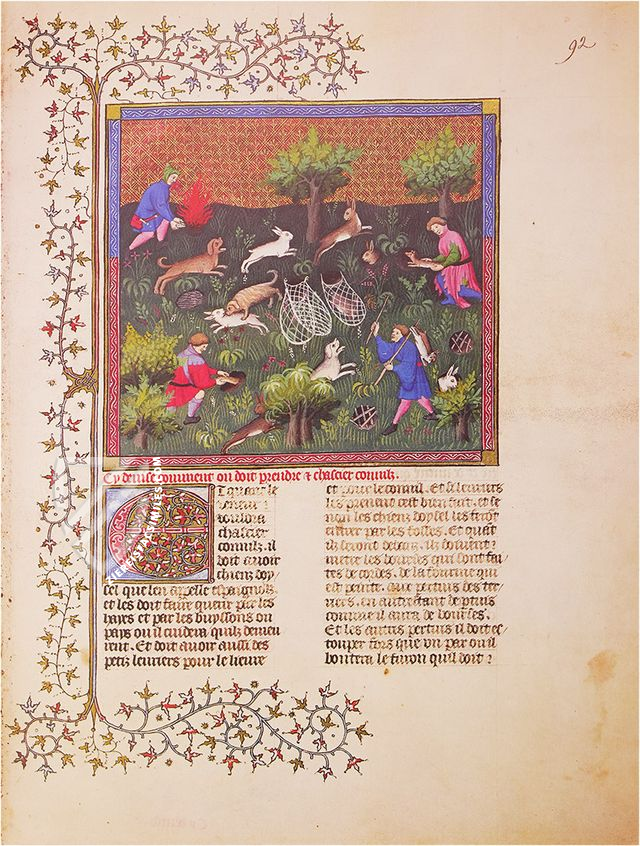
#1 Gaston Phoebus - Le Livre de la chasse
Language: German
(under 1,000€)
#2 Libro de la Caza
Language: Spanish
(3,000€ - 7,000€)
#3 Libro de la Caza
Language: Spanish
(3,000€ - 7,000€)
- Treatises / Secular Books
- Apocalypses / Beatus
- Astronomy / Astrology
- Bestiaries
- Bibles / Gospels
- Chronicles / History / Law
- Geography / Maps
- Saints' Lives
- Islam / Oriental
- Judaism / Hebrew
- Single Leaf Collections
- Leonardo da Vinci
- Literature / Poetry
- Liturgical Manuscripts
- Medicine / Botany / Alchemy
- Music
- Mythology / Prophecies
- Psalters
- Other Religious Books
- Games / Hunting
- Private Devotion Books
- Other Genres
- Afghanistan
- Armenia
- Austria
- Belgium
- Belize
- Bosnia and Herzegovina
- China
- Colombia
- Costa Rica
- Croatia
- Cyprus
- Czech Republic
- Denmark
- Egypt
- El Salvador
- Ethiopia
- France
- Germany
- Greece
- Guatemala
- Honduras
- Hungary
- India
- Iran
- Iraq
- Israel
- Italy
- Japan
- Jordan
- Kazakhstan
- Kyrgyzstan
- Lebanon
- Liechtenstein
- Luxembourg
- Mexico
- Morocco
- Netherlands
- Palestine
- Panama
- Peru
- Poland
- Portugal
- Romania
- Russia
- Serbia
- Spain
- Sri Lanka
- Sweden
- Switzerland
- Syria
- Tajikistan
- Turkey
- Turkmenistan
- Ukraine
- United Kingdom
- United States
- Uzbekistan
- Vatican City
- A. Oosthoek, van Holkema & Warendorf
- Aboca Museum
- Ajuntament de Valencia
- Akademie Verlag
- Akademische Druck- u. Verlagsanstalt (ADEVA)
- Aldo Ausilio Editore - Bottega d’Erasmo
- Alecto Historical Editions
- Alkuin Verlag
- Almqvist & Wiksell
- Amilcare Pizzi
- Andreas & Andreas Verlagsbuchhandlung
- Archa 90
- Archiv Verlag
- Archivi Edizioni
- Arnold Verlag
- ARS
- Ars Magna
- ArtCodex
- AyN Ediciones
- Azimuth Editions
- Badenia Verlag
- Bärenreiter-Verlag
- Belser Verlag
- Belser Verlag / WK Wertkontor
- Benziger Verlag
- Bernardinum Wydawnictwo
- BiblioGemma
- Biblioteca Apostolica Vaticana (Vaticanstadt, Vaticanstadt)
- Bibliotheca Palatina Faksimile Verlag
- Bibliotheca Rara
- Boydell & Brewer
- Bramante Edizioni
- Bredius Genootschap
- Brepols Publishers
- British Library
- C. Weckesser
- Caixa Catalunya
- Canesi
- CAPSA, Ars Scriptoria
- Caratzas Brothers, Publishers
- Carus Verlag
- Casamassima Libri
- Centrum Cartographie Verlag GmbH
- Chavane Verlag
- Christian Brandstätter Verlag
- Circulo Cientifico
- Club Bibliófilo Versol
- Club du Livre
- CM Editores
- Collegium Graphicum
- Collezione Apocrifa Da Vinci
- Comissão Nacional para as Comemorações dos Descobrimentos Portugueses
- Coron Verlag
- Corvina
- CTHS
- D. S. Brewer
- Damon
- De Agostini/UTET
- De Nederlandsche Boekhandel
- De Schutter
- Deuschle & Stemmle
- Deutscher Verlag für Kunstwissenschaft
- DIAMM
- Droz
- E. Schreiber Graphische Kunstanstalten
- Ediciones Boreal
- Ediciones Grial
- Ediclube
- Edições Inapa
- Edilan
- Editalia
- Edition Deuschle
- Edition Georg Popp
- Edition Leipzig
- Edition Libri Illustri
- Editiones Reales Sitios S. L.
- Éditions de l'Oiseau Lyre
- Editions Medicina Rara
- Editorial Casariego
- Editorial Mintzoa
- Editrice Antenore
- Editrice Velar
- Edizioni Edison
- Egeria, S.L.
- Eikon Editores
- Electa
- Emery Walker Limited
- Enciclopèdia Catalana
- Eos-Verlag
- Ephesus Publishing
- Ernst Battenberg
- Eugrammia Press
- Extraordinary Editions
- Fackelverlag
- Facsimila Art & Edition
- Facsimile Editions Ltd.
- Facsimilia Art & Edition Ebert KG
- Faksimile Verlag
- Feuermann Verlag
- Folger Shakespeare Library
- Franco Cosimo Panini Editore
- Friedrich Wittig Verlag
- Fundación Hullera Vasco-Leonesa
- G. Braziller
- Gabriele Mazzotta Editore
- Gebr. Mann Verlag
- Gesellschaft für graphische Industrie
- Getty Research Institute
- Giovanni Domenico de Rossi
- Giunti Editore
- Graffiti
- Grafica European Center of Fine Arts
- Guido Pressler
- Guillermo Blazquez
- Gustav Kiepenheuer
- H. N. Abrams
- Harrassowitz
- Harvard University Press
- Helikon
- Hendrickson Publishers
- Henning Oppermann
- Herder Verlag
- Hes & De Graaf Publishers
- Hoepli
- Holbein-Verlag
- Houghton Library
- Hugo Schmidt Verlag
- Idion Verlag
- Il Bulino, edizioni d'arte
- ILte
- Imago
- Insel Verlag
- Insel-Verlag Anton Kippenberger
- Instituto de Estudios Altoaragoneses
- Instituto Nacional de Antropología e Historia
- Introligatornia Budnik Jerzy
- Istituto dell'Enciclopedia Italiana - Treccani
- Istituto Ellenico di Studi Bizantini e Postbizantini
- Istituto Geografico De Agostini
- Istituto Poligrafico e Zecca dello Stato
- Italarte Art Establishments
- Jan Thorbecke Verlag
- Johnson Reprint Corporation
- Josef Stocker
- Josef Stocker-Schmid
- Jugoslavija
- Karl W. Hiersemann
- Kasper Straube
- Kaydeda Ediciones
- Kindler Verlag / Coron Verlag
- Kodansha International Ltd.
- Konrad Kölbl Verlag
- Kurt Wolff Verlag
- La Liberia dello Stato
- La Linea Editrice
- La Meta Editore
- Lambert Schneider
- Landeskreditbank Baden-Württemberg
- Leo S. Olschki
- Les Incunables
- Liber Artis
- Library of Congress
- Libreria Musicale Italiana
- Lichtdruck
- Lito Immagine Editore
- Lumen Artis
- Lund Humphries
- M. Moleiro Editor
- Maison des Sciences de l'homme et de la société de Poitiers
- Manuscriptum
- Martinus Nijhoff
- Maruzen-Yushodo Co. Ltd.
- MASA
- Massada Publishers
- McGraw-Hill
- Metropolitan Museum of Art
- Militos
- Millennium Liber
- Müller & Schindler
- Nahar - Stavit
- Nahar and Steimatzky
- National Library of Wales
- Neri Pozza
- Nova Charta
- Oceanum Verlag
- Odeon
- Orbis Mediaevalis
- Orbis Pictus
- Österreichische Staatsdruckerei
- Oxford University Press
- Pageant Books
- Parzellers Buchverlag
- Patrimonio Ediciones
- Pattloch Verlag
- PIAF
- Pieper Verlag
- Plon-Nourrit et cie
- Poligrafiche Bolis
- Presses Universitaires de Strasbourg
- Prestel Verlag
- Princeton University Press
- Prisma Verlag
- Priuli & Verlucca, editori
- Pro Sport Verlag
- Propyläen Verlag
- Pytheas Books
- Quaternio Verlag Luzern
- Reales Sitios
- Recht-Verlag
- Reichert Verlag
- Reichsdruckerei
- Reprint Verlag
- Riehn & Reusch
- Roberto Vattori Editore
- Rosenkilde and Bagger
- Roxburghe Club
- Salerno Editrice
- Saltellus Press
- Sandoz
- Sarajevo Svjetlost
- Schöck ArtPrint Kft.
- Schulsinger Brothers
- Scolar Press
- Scrinium
- Scripta Maneant
- Scriptorium
- Shazar
- Siloé, arte y bibliofilia
- SISMEL - Edizioni del Galluzzo
- Sociedad Mexicana de Antropología
- Société des Bibliophiles & Iconophiles de Belgique
- Soncin Publishing
- Sorli Ediciones
- Stainer and Bell
- Studer
- Styria Verlag
- Sumptibus Pragopress
- Szegedi Tudomànyegyetem
- Taberna Libraria
- Tarshish Books
- Taschen
- Tempus Libri
- Testimonio Compañía Editorial
- Thames and Hudson
- The Clear Vue Publishing Partnership Limited
- The Facsimile Codex
- The Folio Society
- The Marquess of Normanby
- The Richard III and Yorkist History Trust
- Tip.Le.Co
- TouchArt
- TREC Publishing House
- TRI Publishing Co.
- Trident Editore
- Tuliba Collection
- Typis Regiae Officinae Polygraphicae
- Union Verlag Berlin
- Universidad de Granada
- University of California Press
- University of Chicago Press
- Urs Graf
- Vallecchi
- Van Wijnen
- VCH, Acta Humaniora
- VDI Verlag
- VEB Deutscher Verlag für Musik
- Verlag Anton Pustet / Andreas Verlag
- Verlag Bibliophile Drucke Josef Stocker
- Verlag der Münchner Drucke
- Verlag für Regionalgeschichte
- Verlag Styria
- Vicent Garcia Editores
- W. Turnowski Ltd.
- W. Turnowsky
- Waanders Printers
- Wiener Mechitharisten-Congregation (Wien, Österreich)
- Wissenschaftliche Buchgesellschaft
- Wissenschaftliche Verlagsgesellschaft
- Wydawnictwo Dolnoslaskie
- Xuntanza Editorial
- Zakład Narodowy
- Zollikofer AG

